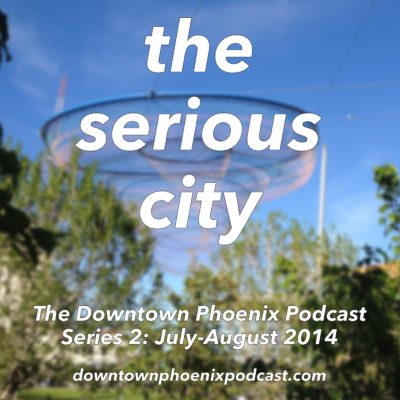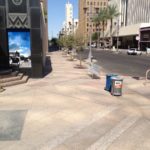[editorial note: The following statement was given to the Site Plan Review hearing regarding the proposed apartment complex at Central Avenue and McDowell Road in midtown Phoenix earlier today. For additional context and comment, please read the “Almost Missed: Central & McDowell” essay, published 18 July 2014.]
 As we have seen this afternoon, a siteplan for an apartment complex at a key corner in the City of Phoenix has been presented.
As we have seen this afternoon, a siteplan for an apartment complex at a key corner in the City of Phoenix has been presented.
Many people here have talked about where this building is but I want to explore a different dimension: when this building is in the Phoenix urban story. Recently, Downtown Phoenix played host to two large-scale music festivals attracting thousands of people, the VIVA PHX festival on March 7 and the weekend-long McDowell Mountain Music Festival at Hance Park at the end of March. Today also marks the return to classes for the students at Arizona State University, including the almost-20,000 students studying at the downtown Phoenix campus alone. Major events of the February 2015 Super Bowl will be sited in Downtown.
Speaking of Hance Park, over two thousand people showed up at Hance Park on March 27 to see the unveiling of the new Hance Park Master Plan to get a feel for what public space and the urban ethic in Phoenix will be. Part of the success of that plan depends on increased density around the park; while this project provides modest density, it is nowhere near what it can or should be. Actually, the success of many urban-focused initiatives depends on increased density in our urban core. There is interest from both current and future urban dwellers—and from those in the urban academy—that the City of Phoenix get this urban moment right.
The City of Phoenix’s zoning scheme cites this area as a “downtown gateway” as part of the Downtown Zoning plan. I see it, too, as a midtown gateway, welcoming people to midtown Phoenix and our grand street, Central Avenue. As part of the Downtown Gateway, buildings are allowed to go up to 250 feet. While I am keenly aware that height and good urban design are not always congruent, a good urban design makes gestures to its geographic place and its moment in history. This is an once-in-a-lifetime opportunity to put something of quality compatible with place and time on this site…but this project falls woefully short.
As City Hall and community leaders work through their approval or disapproval processes, there is only one question that should be considered: “Is this project worthy of being a gateway to downtown Phoenix?”
Thank you.


 One of the common criticisms of THE SERIOUS CITY is that people think it tries to invalidate existing ways of thinking about cities, place, and context. As I see it, that couldn’t be farther from the truth. This is a different way of thinking, true, but it builds upon all constructive ways of thinking about cities. It puts the focus of its thought on the policy side of the spectrum as more important than design.
One of the common criticisms of THE SERIOUS CITY is that people think it tries to invalidate existing ways of thinking about cities, place, and context. As I see it, that couldn’t be farther from the truth. This is a different way of thinking, true, but it builds upon all constructive ways of thinking about cities. It puts the focus of its thought on the policy side of the spectrum as more important than design. This week has been a perfect convergence of several events, conversations, and discoveries from the urban academy. (I love it when convergences like these happen!)
This week has been a perfect convergence of several events, conversations, and discoveries from the urban academy. (I love it when convergences like these happen!)
